( )


( )
Copyright 2002 by Kevin L. Williams, Oasis Newsfeatures, Inc.
Photographs copyright 2002 by Laurie Smith
All rights reserved. No part of this book may be reproduced in any form, except brief excerpts for the purpose of review, without written permission of the publisher.

Ten Speed Press
Box 7123
Berkeley, California 94707
www.tenspeed.com
Distributed in Australia by Simon & Schuster Australia, in Canada by Ten Speed Press Canada, in New Zealand by Southern Publishers Group, in South Africa by Real Books, and in the United Kingdom and Europe by Publishers Group UK.
Cover and text design by Nancy Austin
Photographs on ). All other photographs by Laurie Smith.
Some of the material in this book was originally published in The Amish Cook Cookbook, copyright 1993 by Kevin L. Williams, Oasis Newsfeatures, Inc.
Library of Congress Cataloging-in-Publication Data
Coblentz, Elizabeth.
Recollections and recipes from an old order Amish family / Elizabeth
Coblentz with Kevin Williams.
p. cm.
Includes index.
ISBN-10: 1-58008-214-9
ISBN-13: 978-1-58008-214-3
eBook ISBN: 978-1-60774-669-0
1. Cookery, Amish. 2. AmishUnited StatesSocial life and customs. I. Williams, Kevin. II. Title.
TX715 .C643 2002
641.566dc21
2002004200
v3.1
In Memoriam
Benjamin Coblentz
(19312000)
Table of Contents
Acknowledgments
Thanks goes to my daughters Verena and Susan, who still live at home with me. Also thank you to all my children and their families, including my daughters Liz, Leah, Lovina, and Emma, and my sons, Amos and Albert. I could not have written this book without your support and encouragement.
Elizabeth Coblentz
Special thanks to Cathy and Bill Patterson for your meticulous recipe testing and tasting, and to Sharon Fuge and Jessica Alcorn for your time and effort. Thanks also to my wonderful girlfriend, Rachel Diver, for your patience and encouragement, and for serving as a sample reader and supporter. And a final thank you to my parents, Jim and Rita, and my brother, Geoff, for your support throughout my Amish odyssey.
Special thanks also goes to our project editor, Julie Bennett, and the folks at Ten Speed Press for their incredible patience and respect for Amish cultural traditions. Without this sensitivity this project would not have been possible, and the result is a book unparalleled in its authenticity.
Kevin Williams

( )

( )
Introduction
A weathered, calloused hand directs a plastic ballpoint pen across a piece of lined notebook paper, stringing simple sentences into poignant recollections. Its the plastic pen that seems slightly out of place, as a black-bonnetclad woman writes by the warm glow of a kerosene lamp. If the pen were a quill, this scene would conjure another century, perhaps a pioneer prairie home in 1850s America or a rustic kitchen in seventeenth-century Switzerland. As I stand by the stove to warm myself, the woman slowly writes, spinning tales from a bygone era, of quilting bees, big family breakfasts, barn raisings, and church dinners.
In the adjoining room, someone is singing a vaguely haunting tune, something between a song and a chant. I cant understand the words, which are sung in Swiss, but I know that Im listening to a sound from another time and place. Surveying the simple yet comfortable surroundings, I have to remind myself that this is neither the nineteenth century nor a remote Swiss village. This is the year 2001, in the heart of Midwestern Indiana, and the Amish woman writing quietly at her well-worn desk is Elizabeth Coblentz, an unexpected heroine known to thousands of adoring readers across the United States as the Amish Cook.
Since one fateful day in July 1991, when I happened upon the Coblentzs weathered two-story clapboard farmhouse, Elizabeth and I have been partners in an unprecedented writer-editor relationship. Every week Elizabeth sends me the handwritten text for The Amish Cook, a recipe column that currently appears in more than ninety newspapers across the country. Her uncomplicated descriptions of daily life and meals in an Old Order Amish community come to me by mail because the doctrines of Elizabeths religion forbid her from owning a telephone, or using a fax machine or computer. I type up Elizabeths words, make sure the recipes are complete, then publish them for the world to enjoy. With all the modern methods of communication closed to us, the production of a weekly column has been nothing short of a monumental challenge. However, the positive feedback weve received from Elizabeths numerous fans has made the unusual working arrangement more than worth it.
How It All Began
I was standing in the cluttered but comfortable kitchen of an Amish woman named Catherine Eicher when the idea of an Amish cookery column was born. This was in Reading, Michigan, the land of the Amish, where little changesever. Creaking barns tucked into the folds of rolling wheat fields lend a timelessness to this land. In an America where mobility has turned family trees into a tangle of untraceable lineage, the Amish family roots sunk into the soil over a hundred years ago have held fast.
As a junior in an Ohio high school I was assigned a class research project. Each student had to select an item out of the newspaper and write a research paper on it. A small article in USA Today captured my interest. It was about a giant chemical corporation seeking a permit to build an incinerator on prime Amish farmland outside of Mansfield, Ohio. I had held a mild interest in the Amish since my teens, when my parents and I stopped at a roadside cheese stand in Adams County, Ohio. My Dad explained that the bearded man selling homemade cheese out of a buggy was part of a religious group that lives very much like the early American pioneers.
That class assignment started a journey that continues to this day. I submitted my paper to the Ohio state legislature and it became the basis for my first published work: a magazine article in Environmental Action magazine. My local newspaper did a story about my article and then offered me a journalism internship for the summer. Soon after, I took an assignment with a Michigan publication to write a story about the states growing Amish population, which is how I eventually found myself in Catherine Eichers kitchen.
I had been exploring the tiny grids of criss-crossing country roads when I met Mrs. Eicher, a stout, friendly woman who was cultivating tomatoes, radishes, and rhubarb. She invited me into her kitchen, where kettles and copper pots dangled from hooks in the ceiling and the ever-present smell of rhubarb drifted through the room on a scant breeze. Mrs. Eicher had a small stack of handwritten cookbooks that she sold for a couple of dollars. Mothers Favorite Recipes had a blue cardboard cover with flowers on the front, and someone had photocopied the pages and stapled them into book form. I bought one and took it home.
The vision of Catherine Eichers worldand the charm of that cookbookstayed with me as I returned to Ohio to write my magazine article. It was 1991, the start of the Internet boom and the last decade of the century. The Amish had stirred something within me. Although they seem anachronistic, they are also vaguely reassuring, a touchstone to a lost era. For me, the Amish represent a living link between a simpler time and todays more chaotic world. They represent one of the last remnants of an agrarian America. I figured that if I had this yearning for something meaningful, then others might be looking for it as well. And just like that, The Amish Cook column began to solidify in my mind. Before long, I was headed back to Catherine Eichers on a mission to persuade her to write a newspaper column.
Next page
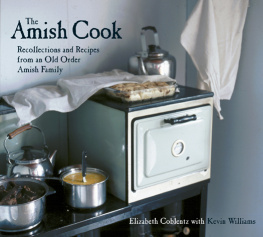
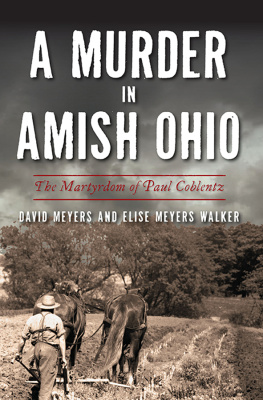



![Beverly M Lewis] - The Beverly Lewis Amish Heritage Cookbook](/uploads/posts/book/96304/thumbs/beverly-m-lewis-the-beverly-lewis-amish-heritage.jpg)
